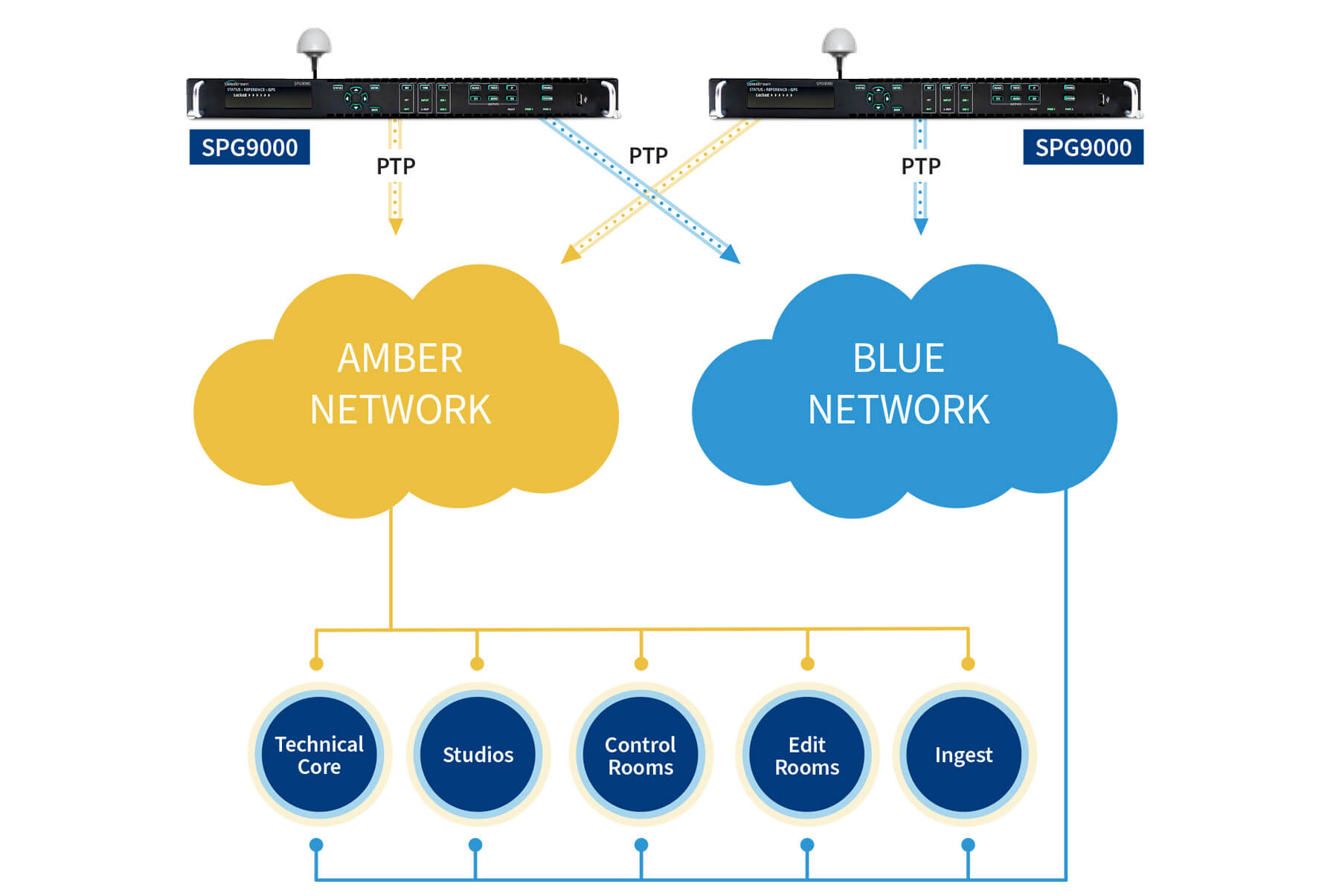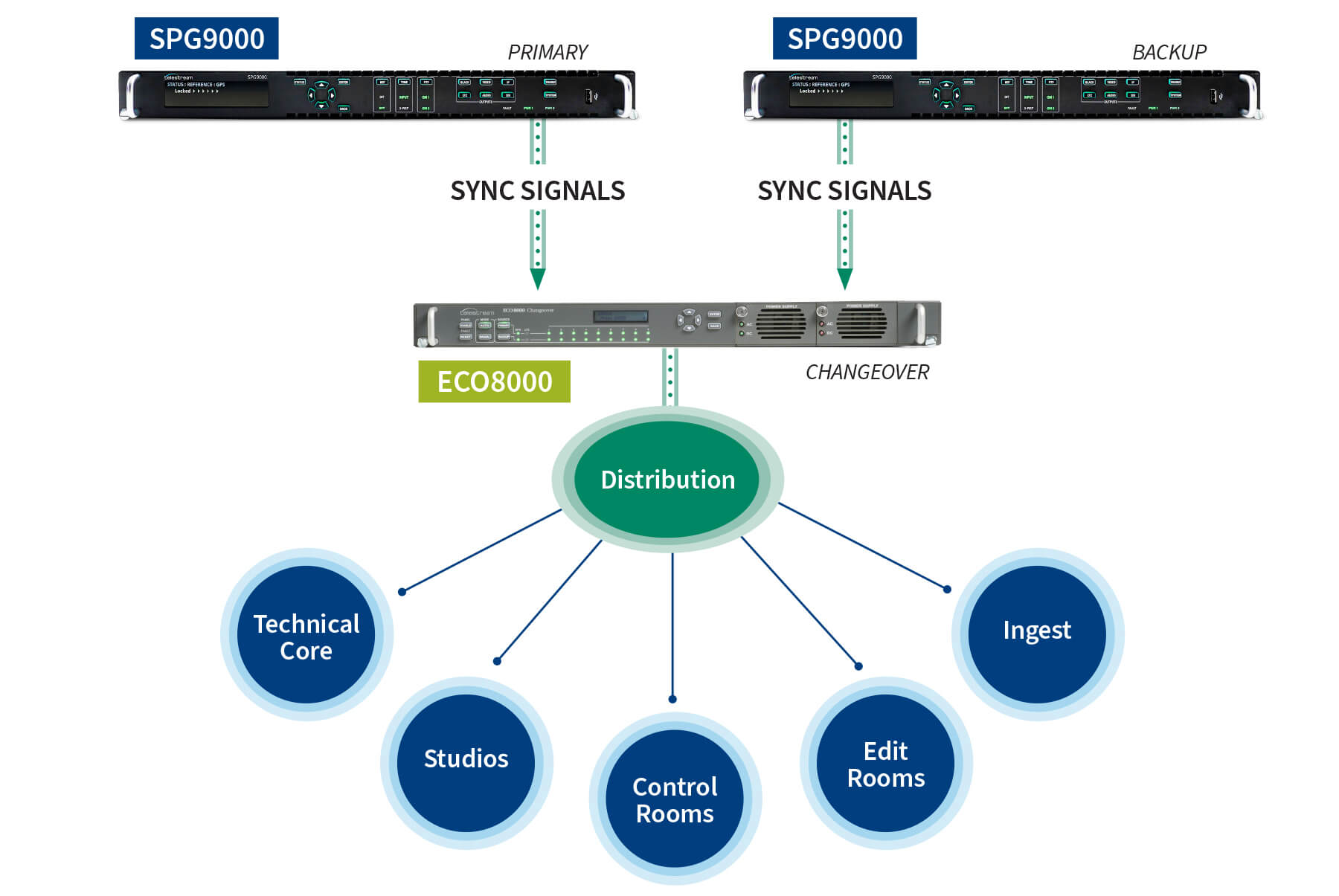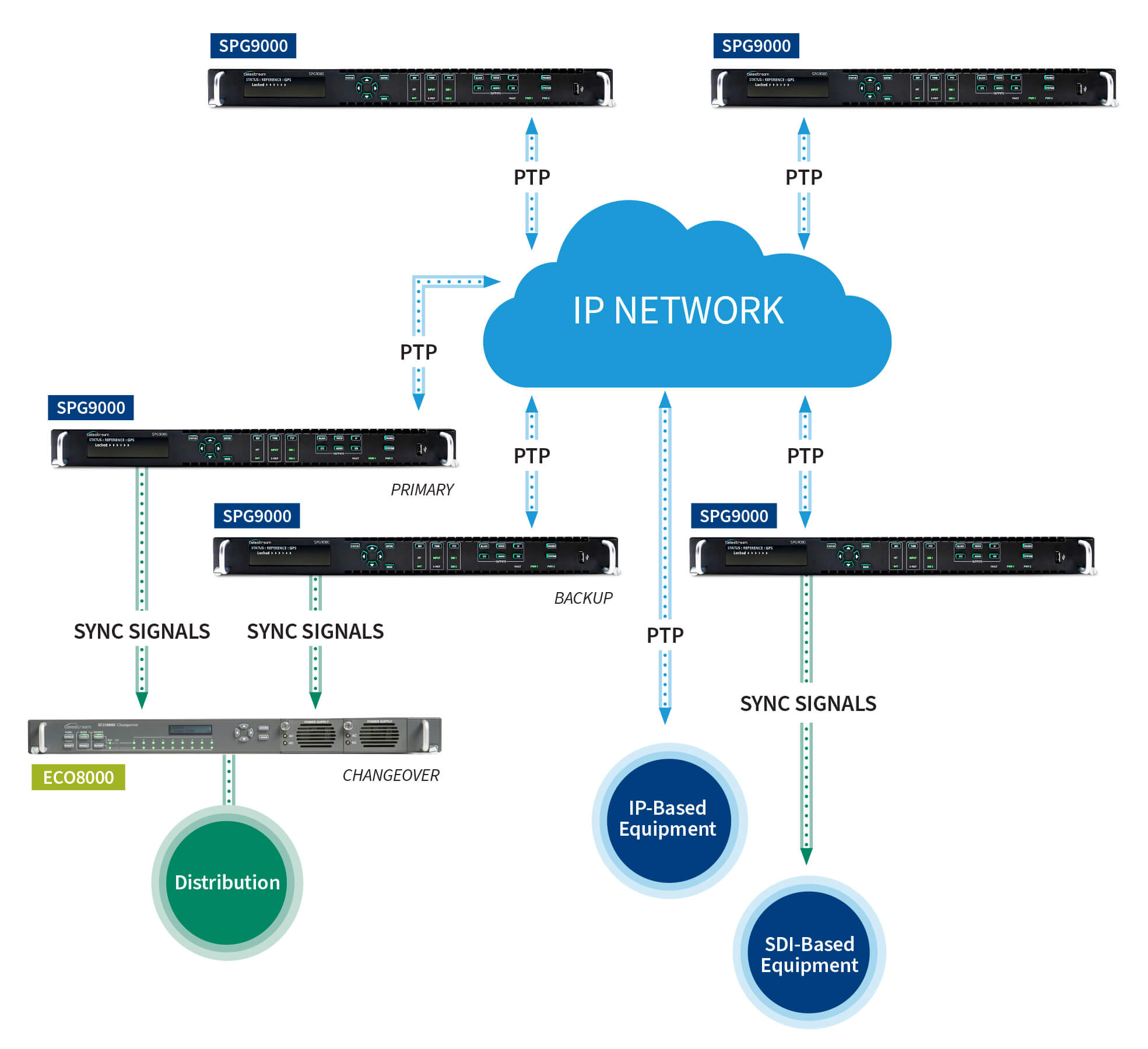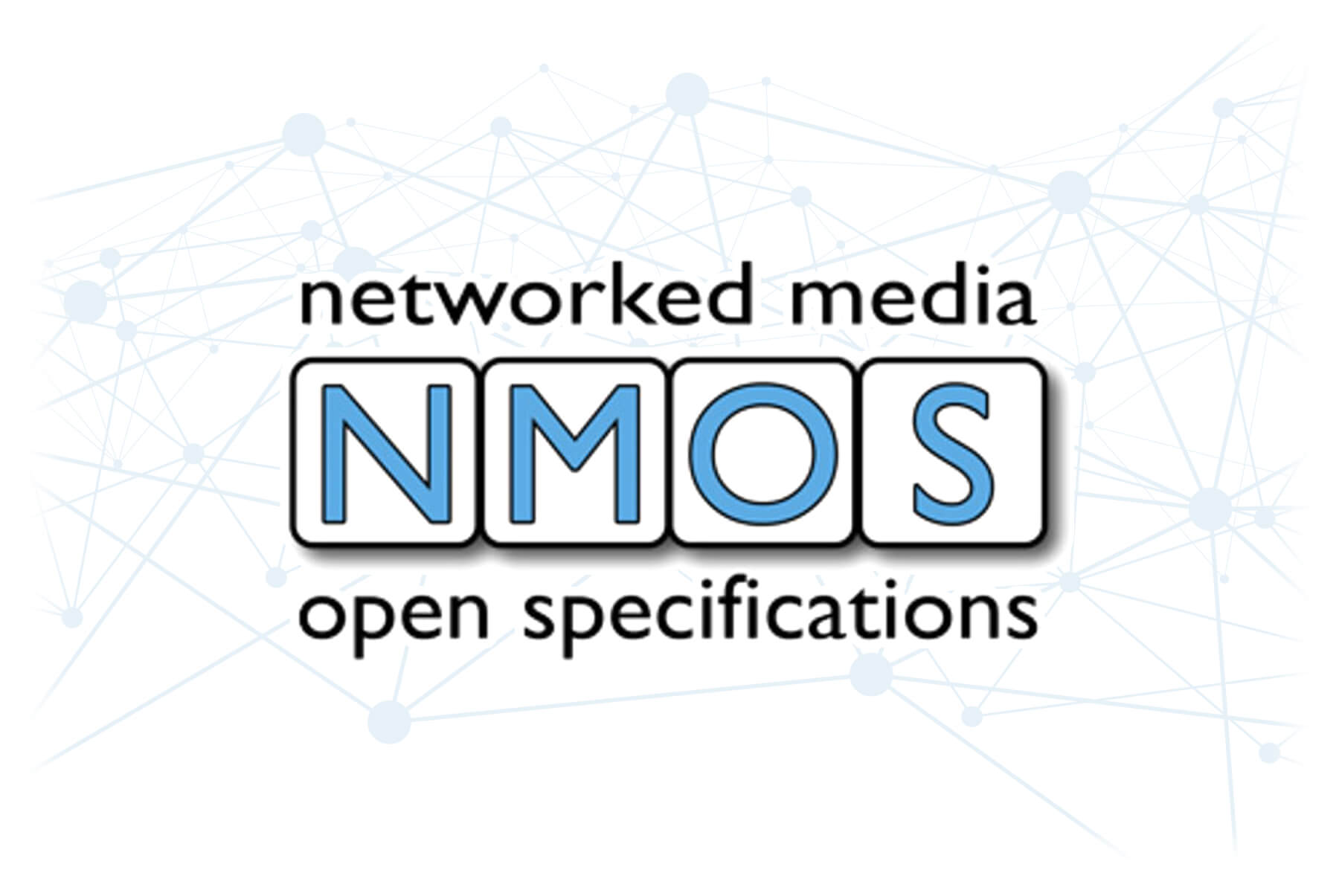Next-generation system for all the synchronization, timing and reference test signal generation needs in your facility
Introducing the SPG9000 – your complete sync generation solution
- Four independent ports for PTP, supporting multiple leader, dual follower, and follower + leader configurations for redundant amber/blue networks.
- Integrated multi-system (GPS, GLONASS, BeiDou, Galileo, QZSS) dual-band GNSS receiver for a highly accurate and reliable timing source
- Analog genlock input and multiple sync outputs for legacy and hybrid SDI/IP facilities
- Multiple video/audio/data test signal generators for formats from SD to HD/2K to UHD/4K
- 4 multi-rate (SD-SDI to 12G-SDI) SDI test signal outputs
- 2 10G/25G Ethernet ports for ST 2110 test signal streams with ST 2022-7 redundancy
- NMOS management of IP sender configuration
- Secure web interface for remote operation and REST-style HTTP API for easy integration with third-party management software

Where Can I Use the SPG9000?
IP-Based Video Facilities
In modern IP-based facilities, PTP is distributed for timing and synchronization to a common source. The SPG9000 can use a GNSS signal as the time source and serve as a PTP grandmaster for the video network. With two independent ports and PTP engines, each SPG9000 can provide PTP for two different domains (e.g. ST 2059 and AES67) or can connect to both sides of redundant networks.
For easy connectivity to spine or backbone switches, each PTP port of the SPG9000 can connect at either 10 Gbps or 1 Gbps line rate, using SFP+ transceiver modules.
Each PTP instance of the SPG9000 can operate as a leader only, a follower only, or use “Ordinary Clock” mode which can adapt between leader and follower as required. For example, if GNSS-based time synchronization is not available (perhaps because there is no clear view of the sky for the antenna), a pair of SPG9000 systems can still function as a primary + backup pair for redundancy. The backup will use PTP to sync to the primary, and takeover with no time disturbance when it switches from follower to leader.
The SPG9000 can also function as an NMOS-controlled media sender, generating video, audio and data reference test signals over ST 2110 IP streams. The two 25 Gbps ports for IP traffic can operate independently or as redundant links per ST 2022-7. PTP can operate in-band with ST 2110 test signal streams using these two ports.

SDI/Analog Video Facilities
The SPG9000 is a full-featured sync pulse generator, providing all the necessary reference signals for an SDI-based video facility. The SPG9000 can lock to a GNSS signal or genlock to another SPG. It has six analog outputs for NTSC/PAL black burst, HD tri-level sync, 10 MHz continuous wave, or 1 pulse-per-second signals, each with independent timing offsets. Time code can be distributed from four LTC outputs and from VITC on any NTSC/PAL black outputs. Word Clock and Digital Audio Reference Signal (DARS) outputs are available for audio reference.
The SPG9000 also includes four multi-rate SDI test signal outputs that can operate independently for SD, HD-SDI (1.5G and 3G), and UHD (6G and 12G-SDI) formats.
Along with the companion ECO8000 changeover unit, a pair of SPG9000 units (primary and backup) comprise a highly available synchronization solution.

Hybrid SDI/IP Video Facilities
The SPG9000 is ideal for facilities that have a hybrid mix of IP-based equipment and SDI/analog equipment. SPG9000s can serve as PTP grandmasters for the facility’s time and synchronization source. PTP is distributed through the facility, and directly to IP-based devices. At the network edge, additional SPG9000 units (either standalone or paired in a primary/backup configuration with an ECO8000) can operate as PTP followers and lock to the active grandmaster. This reference is then used to generate analog sync and time code signals for SDI/analog equipment that uses a traditional genlock input. This system architecture ensures that all equipment in the facility is synchronized to the same time source.
Test signal outputs of each SPG9000 can be configured to duplicate the same video test patterns to both IP and SDI outputs, or they can be configured to use separate test patterns.

Key Features
Flexible Configuration Options for Any System Architecture
The SPG9000 offers a complete set of reference inputs and outputs, supporting a wide variety of system designs. The base configuration includes all the features of a complete sync pulse generator, and all options are licensed so that they can be purchased with the base unit or any time later to upgrade the system.
The SPG9000 has multiple options for setting the internal clock reference (frequency and time-of-day). It can lock to a received GNSS signal, to another PTP grandmaster, or to another sync generator or an external atomic clock using the analog genlock input.
The loop-through genlock input can lock to many different types of analog synchronization signals, including NTSC and PAL black burst, HD tri-level sync signals for all common 1080-line and 720-line frame rates and formats, and continuous wave (CW) signals at 10 MHz.


Resilient to Interruption and Reliable for Continuous Operation
Resiliency and reliability are essential attributes for a timing reference generator since it is a mission-critical component for the video facility.
The SPG9000 has a high-quality oven-controlled micro-electromechanical system (MEMS) oscillator for its internal clock. If the received GNSS signal or genlock input signal is temporarily lost, the SPG9000 will switch to holdover mode in which this clock maintains its time and phase from the previous lock. When the reference input signal is restored, the holdover recovery process adjusts the clock slowly to eliminate any accumulated phase difference. Avoiding an abrupt “jam” when the SPG9000 is re-locked ensures that no “synchronization shock” will be observed by follower devices.
Most facilities require the timing reference to be available continuously and the SPG9000 has an innovative dual power supply system to assist high availability. Unlike simpler devices, the SPG9000 has a designated active power supply and an idle backup supply. This ensures that they are not used at the same rate and will not potentially fail at about the same time. The SPG9000 will monitor the temperature-weighted hours of the active supply and alert the user when it approaches the rated limit. The backup supply undergoes a brief load test automatically each day and the user can be notified if this test fails.
Integrated Dual-Band GNSS Receiver
In addition to their main purpose of providing position information, Global Navigation Satellite Systems also provide highly accurate time-of-day information. Video systems can use this time to compute the precise number of video and audio frames since the “epoch” date and time, thereby synchronizing signals even from disconnected systems.
The SPG9000 has an integrated multi-GNSS, dual-band receiver, supporting GPS, GLONASS, Galileo, BeiDou, and QZSS satellite constellations at L1 and L5 frequencies as applicable. Unlike “smart” antennas that include an internal receiver, the SPG9000’s antenna produces a simple RF signal that can be brought to the SPG9000 by plain coaxial cable, greatly simplifying installation and maintenance.
The SPG9000 constantly monitors the received GNSS signal, showing the ID, status, and signal strength of each satellite currently in view. This information can be viewed on the web interface and retrieved via the HTTP API, providing valuable diagnostic information when investigating signal reception issues.


Complete PTP Solution for Today’s IP Video Networks
The SPG9000 includes an advanced implementation of the Precision Time Protocol, making it the ideal choice for a facility’s timing and synchronization reference.
Both Leader and Follower modes are supported, and the SPG9000 can also operate as an “Ordinary Clock” that adapts between the two modes depending on dynamic network conditions. With four independent PTP instances, the SPG9000 can operate as a multiple Leaders serving different domains and/or profiles, as a dual Follower connected to the two sides of a redundant network, or simultaneously as a dual Follower synchronized to an upstream grandmaster and as a dual Leader to a separate downstream redundant network. The PTP two ports operate over 1G/10G-capable interfaces (using SFP+ modules) and two PTP ports operate over 10G/25G-capable interfaces (using SFP28 modules) for easy connection to commonly used switch ports.
The SPG9000 supports the three profile types required for media networks: SMPTE ST 2059-2, AES67 Media Profile, and IEEE 1588 Default. Both multicast and unicast communication models are supported, including mixed multicast/unicast mode.
PTP performance monitoring per IEEE 1588-2019 Annex J is supported, with real-time display of delay and offset measurements and message rates. The data is also available via the HTTP API, for easy integration with management dashboards.
The SPG9000 has a unique Dynamic Priority algorithm that minimizes unnecessary grandmaster changes. For example, it is normal and expected behavior for the Best Master Clock Algorithm (BMCA) to cause a switch from a primary (active) leader to a backup (passive) leader when the GNSS signal degrades. But if that signal is restored, the current active leader is equally capable of serving PTP to the network, so there is no need to switch back to the original leader. Dynamic Priority ensures that the unnecessary GM change does not happen, improving stability for ST 2110 and PTP networks.
Powerful Test Signal Generator
Test signals are useful video and audio references that can be used to troubleshoot or verify performance of equipment and network links within the facility. The SPG9000 includes video, audio, and ancillary data generators for four multi-rate (up to 12G) SDI outputs and two 25 Gbps IP outputs.
A wide variety of standard video test patterns are available, such as color bars, monitor calibration patterns, ramps and staircases, and multiburst patterns. Formats and image sizes from standard definition to UHD/4K are supported simultaneously on the independent outputs. User-supplied image files can be loaded onto the instrument and output from the test signal outputs.
A set overlays can be superimposed above the video test signal background. The text ID overlay supports multiple lines of test at a configurable text size, and uses Unicode characters for localized text in many languages. The logo overlay adds an uploaded adds an uploaded image file for network or channnel graphics, for example. The burnt-in time code overlay adds the frame-accurate time code to the test pattern, creating a dynamic test signal.
The SPG9000 has multiple independent audio tone generators that can be embedded into the SDI signals and output as ST 2110-30 IP streams. A special synchronized audio and video sequence can be used to measure AV delay on a companion PRISM monitor.
Ancillary data can be included in the SDI signals and output as ST 2110-40 IP streams. Four different ancillary data types can be generated simultaneously for each output: ancillary time code (ATC), video payload identifier (VPID), user defined static packet (such as Active Format Description) and user-defined dynamic packet (such as captions/subtitles).


NMOS-Enabled Media Sender
Using the Networked Media Open Specifications (NMOS) developed by the Advanced Media Workflow Association (AMWA), the SPG9000 can function as a media device in an IP network.
Using the Discovery & Registration API (IS-04), the SPG9000 can register as a node with sender capabilities. Using the Device Connection Management API (IS-05), receivers can automatically configure IP connections to receive IP streams for test signal content (video, audio, and data).
Remote System Management and Monitoring
The SPG9000 includes several tools to facilitate easy integration with modern management systems and monitoring dashboards.
In addition to the front panel display and keypad for local operation, the SPG9000 has a full-featured easy-to-use web-based interface for remote operation. Access is controlled via user login and password authentication, with both administrator and operator access levels. HTTPS can be used for secure network access per EBU R 143 cybersecurity requirements.
A complete HTTP-based Application Programming Interface (API) is available for client-side software to query the instrument status and to configure its run-time options. Integrated web-based API documentation makes it easy for developers to understand message structures, and to interactively send requests to the instrument and view the responses.
The SPG9000 also utilizes syslog for sending log messages to a remote server. The minimum reported severity level is configurable, to only report error and warning messages or to also report informational system messages, for example.
PTP status and performance monitoring and GNSS receiver status are well-supported by both the HTTP API and syslog. The API conforms with the proposed SMPTE RP 2059-15 data model, providing a vendor-neutral interface for client-side developers.
The SPG9000 has an SNMP agent for system monitoring with traditional management systems. SNMP version 3 is used for security, and the agent supports objects for system and reference status and Trap messages for event notifications.

Companion Changeover Unit

The ECO8000 electronic changeover unit works with a primary + backup pair of SPG9000 units to serve as a highly-reliable redundant system. It utilizes electronic fast switches for near glitch-less sync source switching, minimizing disruption in operation. Dual hot-swappable power supplies ensure continuous availability of reference signals, and signals are passed even when the unit is powered off.
The ECO8000 provides nine user-configurable BNC channels and four LTC channels. Each channel consists of primary and backup inputs, and an output. The system includes six 50 MHz electronic fast switch channels, three 3 GHz relay switch channels, and four LTC channels. The 50 MHz electronic fast switch channels support black burst, HD tri-level sync, AES/DARS, and word clock signals. The 3 GHz relay switch channels support SD/HD/3G-SDI signals as well as most analog reference signals.